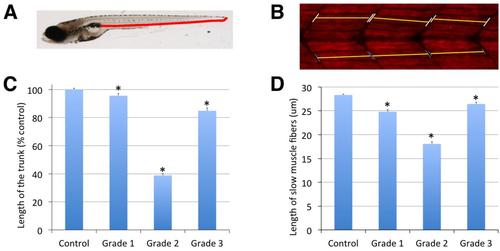Fig. S5
|
Chlorpyrifos-oxon induces reduction in the length of the trunk and axial slow muscle fibers in zebrafish larvae. (A) Lateral view of a control 8 dpf zebrafish larva. Red segment, between the most caudal part of swim bladder and the tip of the tail, corresponds with the “length of the trunk”, the part of the larva containing most of the axial muscle fibers. (B) The length of six slow muscle fibers, at the level of the lower intestine, up and down of the horizontal myoseptum, was measured in larvae control, as well as in larvae exposed for 24 h to 0.1 µM (grade 1), 0.75 µM (grade 2) and 6 µM (grade 3) chlorpyrifos-oxon (5 larvae per experimental group). In order to identify easily slow muscle fibers, whole-mount immunofluorescence analysis was performed by using a primary antibody against myosin heavy chain (F59, from DSHB). Length of the trunk and axial muscle fibers was determined by using the free image analysis software ImageJ (U. S. National Institutes of Health, Bethesda, Maryland, USA, http://imagej.nih.gov/ij/). (C) Length of the trunk was significantly reduced in the all three grades of severity, but specially in grade 2 (n=14-23; p<0.005 for grade 1 and P <0.001 for grade 2 and 3, mean ± s.e.m., one-way ANOVA with Dunnett’s multiple comparison test). (D) Length of the slow muscle fibers was significantly reduced in all the grades, but specially in grade 2 larvae (mean ± s.e.m., p<0.001, one-way ANOVA with Dunnett’s multiple comparison test). |

